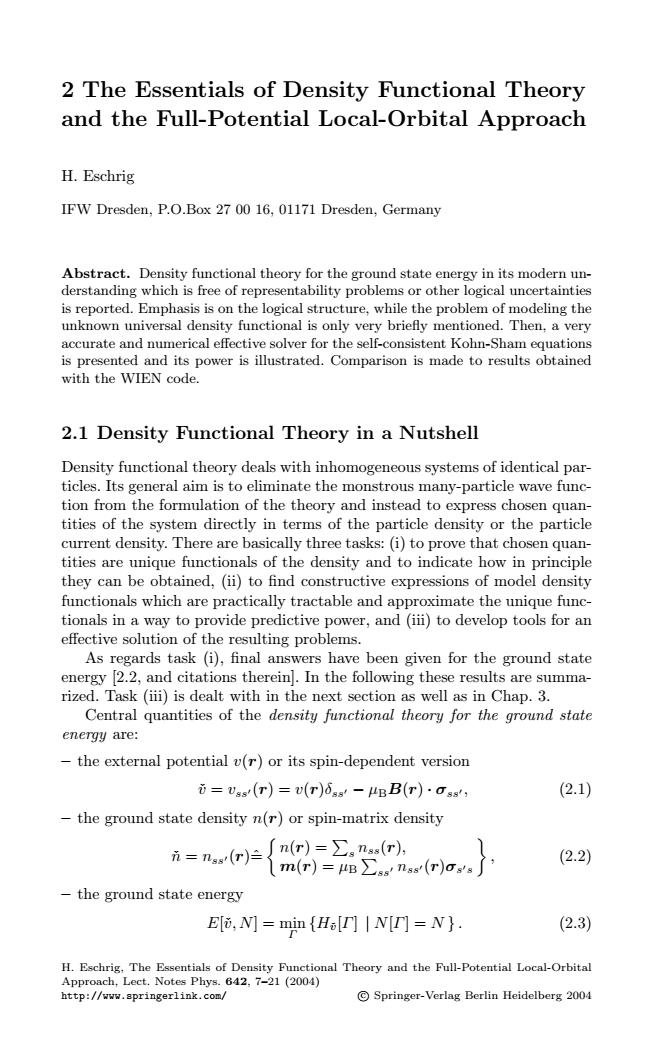正在加载图片...

2 The Essentials of Density Functional Theory and the Full-Potential Local-Orbital Approach H.Eschrig IFW Dresden,P.O.Box 27 00 16,01171 Dresden,Germany Abstract.Density functional theory for the ground state energy in its modern un- derstanding which is free of representability problems or other logical uncertainties is reported.Emphasis is on the logical structure,while the problem of modeling the unknown universal density functional is only very briefly mentioned.Then,a very accurate and numerical effective solver for the self-consistent Kohn-Sham equations is presented and its power is illustrated.Comparison is made to results obtained with the WIEN code. 2.1 Density Functional Theory in a Nutshell Density functional theory deals with inhomogeneous systems of identical par- ticles.Its general aim is to eliminate the monstrous many-particle wave func- tion from the formulation of the theory and instead to express chosen quan- tities of the system directly in terms of the particle density or the particle current density.There are basically three tasks:(i)to prove that chosen quan- tities are unique functionals of the density and to indicate how in principle they can be obtained,(ii)to find constructive expressions of model density functionals which are practically tractable and approximate the unique func- tionals in a way to provide predictive power,and (iii)to develop tools for an effective solution of the resulting problems. As regards task (i),final answers have been given for the ground state energy 2.2,and citations therein.In the following these results are summa- rized.Task (iii)is dealt with in the next section as well as in Chap.3. Central quantities of the density functional theory for the ground state energy are: the external potential v(r)or its spin-dependent version i=vgs(r)=v(r)6gs-BB(r)·oss, (2.1) the ground state density n(r)or spin-matrix density i=nsrr)=厂n(r)=∑ns(r), 1m(r)=B∑sgns(r)ags了 (2.2) the ground state energy E[,N]=min {H[]N[r]=N}. (2.3) H.Eschrig,The Essentials of Density Functional Theory and the Full-Potential Local-Orbital Approach,Lect.Notes Phys.642,7-21(2004) http://www.springerlink.com/ C Springer-Verlag Berlin Heidelberg 20042 The Essentials of Density Functional Theory and the Full-Potential Local-Orbital Approach H. Eschrig IFW Dresden, P.O.Box 27 00 16, 01171 Dresden, Germany Abstract. Density functional theory for the ground state energy in its modern understanding which is free of representability problems or other logical uncertainties is reported. Emphasis is on the logical structure, while the problem of modeling the unknown universal density functional is only very briefly mentioned. Then, a very accurate and numerical effective solver for the self-consistent Kohn-Sham equations is presented and its power is illustrated. Comparison is made to results obtained with the WIEN code. 2.1 Density Functional Theory in a Nutshell Density functional theory deals with inhomogeneous systems of identical particles. Its general aim is to eliminate the monstrous many-particle wave function from the formulation of the theory and instead to express chosen quantities of the system directly in terms of the particle density or the particle current density. There are basically three tasks: (i) to prove that chosen quantities are unique functionals of the density and to indicate how in principle they can be obtained, (ii) to find constructive expressions of model density functionals which are practically tractable and approximate the unique functionals in a way to provide predictive power, and (iii) to develop tools for an effective solution of the resulting problems. As regards task (i), final answers have been given for the ground state energy [2.2, and citations therein]. In the following these results are summarized. Task (iii) is dealt with in the next section as well as in Chap. 3. Central quantities of the density functional theory for the ground state energy are: – the external potential v(r) or its spin-dependent version vˇ = vss (r) = v(r)δss − µBB(r) · σss , (2.1) – the ground state density n(r) or spin-matrix density nˇ = nss (r) ˆ= n(r) = s nss(r), m(r) = µB ss nss (r)σss , (2.2) – the ground state energy E[ˇv,N] = minΓ {Hvˇ[Γ] | N[Γ] = N } . (2.3) H. Eschrig, The Essentials of Density Functional Theory and the Full-Potential Local-Orbital Approach, Lect. Notes Phys. 642, 7–21 (2004) http://www.springerlink.com/ c Springer-Verlag Berlin Heidelberg 2004���